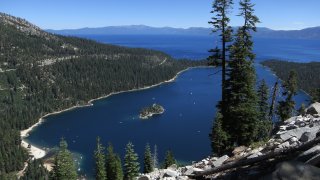
An artist is starting a 1,000-year photography project in hopes of changing the impacts of climate change at Lake Tahoe.
World-renowned conceptual artist and experimental philosopher Jonathon Keats has partnered with Tahoe PublicArt and Sierra Nevada College to install a camera on the East Shore Trail that will capture changes over the next 1,000 years.
"I've been interested for quite a while with the idea of how we can reconcile our lifestyle with the impact on the environment," Keats said.
Keats has been experimenting with long exposure pinhole photography for many years. He installed a 100-year exposure camera in Berlin, Germany but wanted to explore an even longer exposure.
Working with a slowly fading pigment in a pinhole camera, Keats created a camera with a photograph that will theoretically develop over a 1,000 years. He has installed one camera and hopes to install three more that will capture changes in the basin.
The project is called Tahoe Timescape.
"Essentially, Tahoe Timescape is a public art project that aims to photographically document the next 1,000 years of environmental change in the Lake Tahoe Basin," Marina Lowe, Program Administrator for Tahoe Public Art said.
California
The project will act as a time capsule of the way we, in the present, have addressed climate change.
The future generations can see the decisions we've made collectively and the impact we've had on the environment," Keats said.
Even if the project fails in the long run, like if the photograph doesn't develop properly, Keats believes the project can still make an impact in the short term.
"It will make people think about what (the people in the future) might see and change the photograph," Keats said. "It's a feedback loop between the past and the present."
Keats picked Lake Tahoe as the site of his project because it gave him a good opportunity to track environmental change in an entire basin.
Because Keats is not a Tahoe local, he has put the responsibility of the project in the hands of Sierra Nevada College.
Sierra Nevada College has a legal responsibility for the cameras and the photographs, so in a 1,000 years, they will ensure Keats heirs get custody of the photographs.
Also, the school's students will be the custodians of the cameras. Every three years, the students will go out to the site of the cameras and make observations of the changes in the environment that they see.
"It's exciting to work with the school because it allows for a more immediate interaction with the progress," Keats said. "Every three years, they'll go to the cameras to envision what the cameras might show."
Every time the students make their observations, they will be present an exposition about the changes they see, good or bad.
One of the major purposes of the project is to get people in the present to think about the impact they will have on the future.
"I think immediately, I hope that (where we place the camera) becomes a place where people can contemplate even the little things that maybe they could be doing better," Lowe said. "If people can see that if we make the necessary changes, we can see a better future much further down the road."
In addition to the camera on the East Shore Trail, the team hopes to place cameras at Fanny Bridge in Tahoe City, one at Heavenly Ski Resort and Homewood Mountain Resort.
They are still working on special-use permits for those sites.
To find out more about the project, visit http://www.tahoepublicart.com/tahoe-timescape.html.



